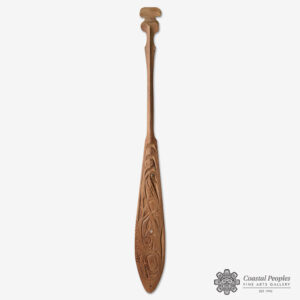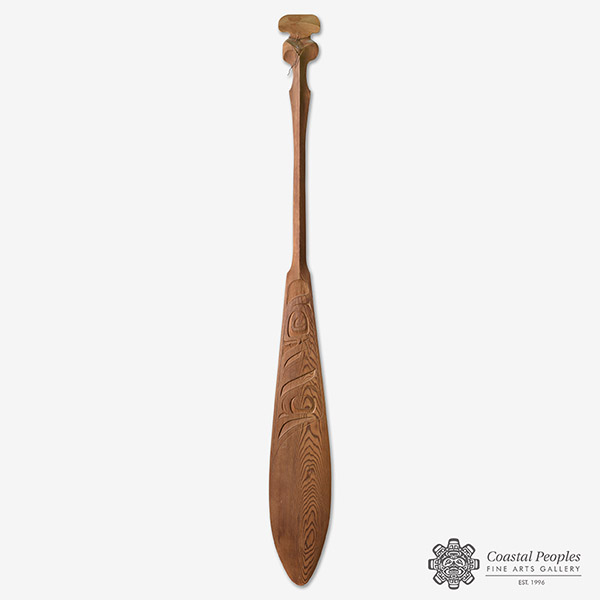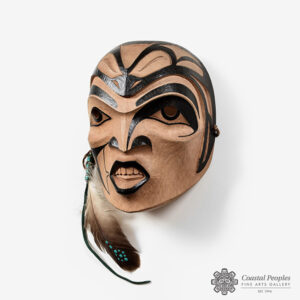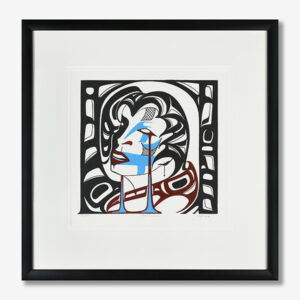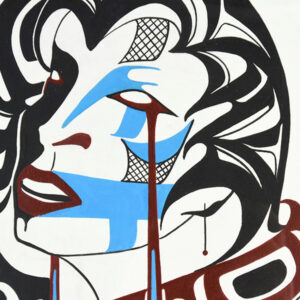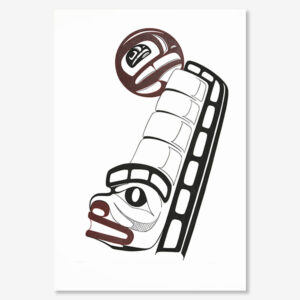Chester (Chaz) Patrick
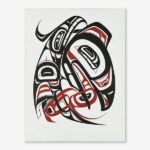
Gitksan Nation
(1958 – 2008)
Chester Patrick was born in 1958 and raised in the village of Gitanmaax near Hazelton, B.C. Always interested in art, Chester was schooled at an early age as a principal dancer with Ksan Performing Arts and later attended the Gitanmaax School of Northwest Coast Indian Art.
Under the guidance of Gitksan Elders and the tutelage of his instructors, Vernon Stephens, Ken Mowatt, Walter Harris, Earl Muldoe and Art Sterritt, Chester’s knowledge of his culture is reflected in his both design and context of his artistry.
During his time at Gitanmaax School he got the nickname “Chaz”- the letter “C” for his first initial and the “Haz” for the first three letters in “Hazelton.” Chester is more commonly known by his nickname Chaz, which he also uses to sign his completed works.
Since 1975, Chaz has worked as an artist. Although his pieces are created primarily in yellow cedar, which provides clean, well-defined cuts that highlight his design, he also paints original works in acrylic paints. Design and context are the fundamental elements found within all his pieces. His repertoire includes cedar flat relief, two-dimensional and three-dimensional design such as masks, bowls, spoons, miniature poles, frontlets, panels, and full-scale poles, while his original paintings illustrate design and oral traditions.
As an artist, Chaz’s gift is to communicate, celebrate and illuminate respect for his culture. Gitksan stories, legends, songs and dances inspire his artwork and he continues to be a student of his art; listening and learning from his culture both past and present. His work can be found in private collections, galleries and public institutions throughout North America and Europe.
Accolades:
2007 British Columbia Creative Achievement Award for First Nations’ Art
Works by this Artist (Present + Past + Public)
Present Works
-
Salmon Paddle
Chester (Chaz) Patrick
RESERVEDRed Cedar wood, Abalone shell
Double-sidedc. 2005
1958-2008 -
Frog Mask
Chester (Chaz) Patrick
Price upon requestRed Cedar wood, Leather, Feather, Acrylic paint
c. 1997 -
Volcano Woman [Framed]
Chester (Chaz) Patrick
CA$1,850.00Acrylic paint on Acid-free paper
2003
Framed
-
-
Salmon Sculpture
Chester (Chaz) Patrick
CA$980.00Exclusive to Coastal Peoples Fine Arts Gallery
Glass; etched and sandblasted (Glass thickness 12mm)
Maple wood base
Salmon are honoured and celebrated by all coastal peoples: the fish serves as a powerful symbol of regeneration, self-sacrifice and perseverance.
Shortages of Salmon are traditionally attributed to human disrespect and refusal to listen to and live by the wisdom of elders. The Pacific Northwest Coast peoples believed that Salmon were actually people with eternal life who lived in a large house far under the ocean. In spring, they put on their Salmon disguises and offered themselves to humans as food.
-
Witness…To Acceptance of Family Legacy
Chester (Chaz) Patrick
CA$800.00Acrylic on Acid-free board
2004
Unframed
-
Orca
Chester (Chaz) Patrick
CA$980.00Exclusive to Coastal Peoples Fine Arts Gallery
Glass; Etched and sandblasted (Glass thickness 12mm)
Maple wood base
Every Household and every clan possessed its own history and traditions in the form of myths and legends. Often describing how an individual had met a supernatural being, in animal form, who had given ownership of certain privileges. These privileges are a highly important part of First Nations life and are retained by particular family groups through their laws of inheritance. Privileges gave an individual status in the community and were more highly valued than any material possession.
In reality there were rights, such as the right to use a figure on a house post, wear a mask or to perform a dance at a ceremony. Very typical of these legends was the tale of Natcitlaneh, who was abandoned on an island by his brothers-in-law, who were jealous of his prowess as a hunter. He was rescued by the sea lions and taken to their village in a cave, where in gratitude for his healing their Chief, gave him supernatural powers which enabled him to carve eight wooden Killerwhales. These came to life when they were placed in the sea and avenged him by killing his brothers-in-law. As a mark of respect, Natcitlaneh built a house and named it Killerwhale House. According to legend the ancestors visited the house, located at the bottom of the ocean and obtained the right to use the Killerwhale as a crest. The Killerwhale was said to have originated from a single great white wolf that leaped into the sea and transformed itself into a Killerwhale, or Orca. That is why they have the white markings on their sides, travel in packs and are such skilled hunters. The Orca is considered to be the ocean manifestation of the wolf and the two animals are considered to be directly related.
Another beautiful legend tells that long ago Orca was one color, black and she lived in the water like all fish. Then she fell in love with Osprey and he with her. The Orca wanted to know so badly what it felt like to fly so she leapt farther and farther out of the water to be close to her love and Osprey spent more and more time close to the water to be near his love. Love has a way of making itself shown and expressed, and when their child was born, she was black like Orca, but with a white belly and head like the Osprey. The Orca has a song so beautiful that all creation is said to stop and listen to the Orca and that to be splashed by the Orca is to ensure great luck and happiness.
Chaz’s beautifully sculptured glass Killerwhales pay tribute to First Nation culture, oral history and traditions. These are testament to an ideology in which we are all interconnected and part of the greater whole- each related and affecting the other.
Past Works
The artist’s Past Works at our Gallery have now sold; however, a custom order may be possible if the artist is available and accepting commissions.


